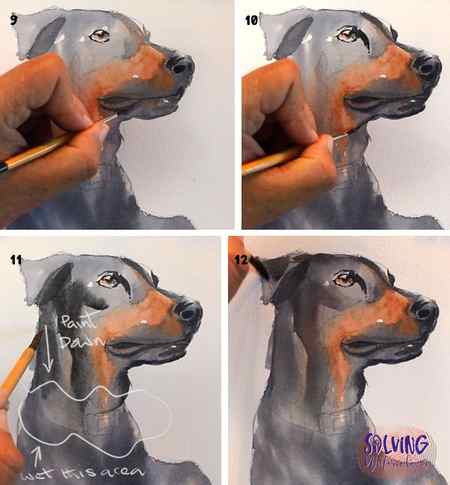Get Instant Access: Price $97
How To Paint A Dog In Watercolor

Further to my recent posts about horses and cats. I thought I’d continue with the animal theme and look at how to paint a dog in watercolor. Now I don’t actually own a dog, I found the reference photo (Below) on pexels.com.


Table Of Contents
If you’d like to follow this tutorial but need some help with the drawing, you can download a pdf file of my drawing here. Print it on to a sheet of A4 watercolor paper. Remember, when printing on to thick watercolor paper, always use your printer’s rear tray. Using your printer’s cassette tray could cause a jam as the thick paper has to bend round the printer’s rollers.
Materials List
Paint
Brushes
Princeton round detail brush 9650R-2 Buy from Amazon
Winsor & Newton Series 150 Bamboo Round #6 Buy From Amazon
Paper
Arches Watercolor Paper Block, Cold Press, 9″ x 12″, 140 pound Buy From Amazon
Miscellaneous
Easy release painters masking tape Buy from Amazon
Adjustable desktop easel Buy From Amazon
Planning In Advance
Understanding how water, paper and paint interact with each other is the first step in planning your painting and really only comes with practice. In this blog post I list the techniques you should be familiar with. Have a look and practice them on scrap paper if you’re not sure about anything.
Study the photo and try and rehearse painting it in your mind first.
Do small postcard sizes rehearsal paintings first to indentify problem areas before you start on a larger painting.
Having a good drawing as your starting point also reduces the guesswork
Apart from the greens in the background, there are only two colors used in this painting, Paynes Grey and Burnt Sienna. As always, the tricky part is to get the right balance of hard and soft edges. In the the first washes, I wanted to allow them to blend. This means painting wet into wet and allowing the two colors the freedom to run into each other.
The danger with wet into wet, is that the colors can and will run into each other somewhat uncontrollably. That’s part of the challenge of watercolor but it’s also part of the fun. When you’re not totally in control of the process you have to work quickly and anticipate problems. It can be frustrating and exhilarating in equal measure.
An alternative method would be to paint the lightest color first i.e. Burnt Sienna. Allow it to dry and then paint the Paynes Grey. It will work but will create distinct and unnaturally hard-edged blocks of color that will end up resembling a painting by numbers picture rather than the loose fresh watercolor painting that for me, is the heart and soul of the medium.
To minimise the paint flow and give yourself a chance, I would suggest keeping the angle of our painting to a maximum angle of thirty degrees. The paint will still flow downwards but not so quickly and uncontrollably.
Decorating your home with personalized artwork is a great way to celebrate one of the most beloved members of the family: your dog. But how do I start? Portrait artist Hannah Stahl explains the 5-step process of commissioning a custom dog portrait.
Because it’s challenging to make a dog sit still for extended periods of time—photos are gold. Aim for photos where the lens of the camera is at the dog’s level. You want the dog to appear eye to eye with you in the portrait, so don’t be afraid to kneel down when photographing. Avoid shooting down at the dog from above.
Lighting is an important part of a great photograph, so be sure to have plenty of lights on if you’re shooting indoors. That said, outdoor photography with natural light is preferable—and sunshine is best!
2. Choose The Background
There are two options for the portrait’s background aesthetic: traditional or modern. The traditional background realistically captures the existing place in which the dog was photographed. This style of background could feature your dog’s favorite space— be it an interior on a couch or a rug for instance, or outside on a patio or lawn. It’s best if the background is present within the chosen photograph of your dog, but it may be possible to create imagined or alternative backgrounds.


In contrast, the modern background creates an empty space around your dog. This approach has a contemporary aesthetic that ennobles the dog by emphasizing their unique silhouette. White and neutral colors are most common in the modern background, while alternative colors can also be used.
3. Decide On Size
Determining the right size for a portrait depends on several factors: The first thing to consider is the size of the wall space where the portrait will be hung. You may have the perfect wall in mind to hang the piece, in which case you’ll measure the spot and have the painting tailor made to fit. The second thing to think about is the scale of the dog in the portrait. It may be most important that your dog is either life size, smaller, or bigger— in which case, you’ll pick the canvas that best suits the size you’d like your dog portrayed. The final consideration is budget, as smaller sized portraits are more affordable than larger portraits. Contact me here for a size/price sheet.







